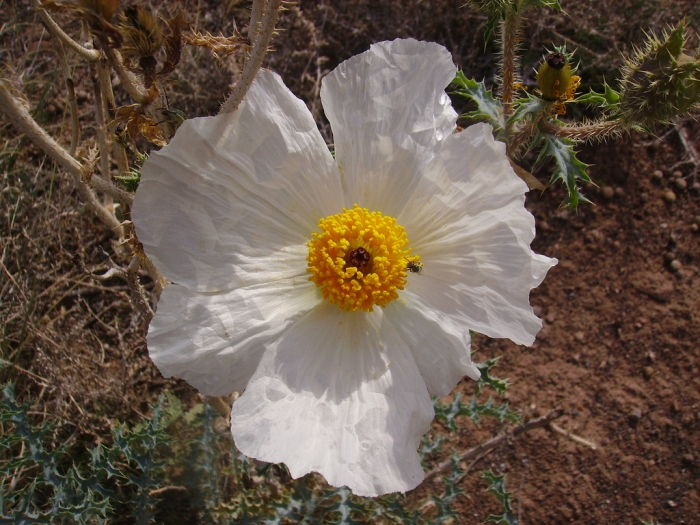Southwestern Pricklypoppy
(Argemone pleiacantha)
Southwestern Pricklypoppy (Argemone pleiacantha)
/
/

Petrified Forest Ranger (Hallie Larsen/NPS)
CC BY 2.0
Image By:
Petrified Forest Ranger (Hallie Larsen/NPS)
Recorded By:
Copyright:
CC BY 2.0
Copyright Notice:
Photo by: Petrified Forest Ranger (Hallie Larsen/NPS) | License Type: CC BY 2.0 | License URL: https://creativecommons.org/licenses/by/2.0 | Uploader: Stickpen | Publisher: Wikimedia Commons | Title: Argemonepleiacantha.jpg | Notes: |




















































Estimated Native Range
Summary
Argemone pleiacantha, commonly known as Southwestern Pricklypoppy, is a deciduous herb that is native to the desert regions, grasslands, and chaparral and scrub areas of the Southwestern United States and Northwest Mexico. This plant can be either an annual or perennial, with branching, erect stems that can reach up to 1.5 meters in height. The entire plant is covered with sharp prickles, which are often dense. Its blue-green leaves are deeply lobed with sharp, toothlike divisions. The flower buds, also prickly, are up to 2 centimeters long and open into large, showy white flowers with petals that can span up to 16 centimeters across. Following flowering, it produces a prickly fruit capsule that can be up to 4.5 centimeters long.
The Southwestern Pricklypoppy is valued for its striking white flowers and architectural form, making it a dramatic addition to xeriscapes and rock gardens. It thrives in full sun and is drought-tolerant, requiring low to medium amounts of water, and prefers well-drained soils. Its ability to adapt to arid conditions makes it a suitable choice for low-water-use gardens. However, gardeners should handle the plant with care due to its prickles and be cautious of its self-seeding habit, which can lead to it spreading in the garden. It is not commonly afflicted by diseases but can be a potential skin irritant due to its prickly nature.CC BY-SA 4.0
The Southwestern Pricklypoppy is valued for its striking white flowers and architectural form, making it a dramatic addition to xeriscapes and rock gardens. It thrives in full sun and is drought-tolerant, requiring low to medium amounts of water, and prefers well-drained soils. Its ability to adapt to arid conditions makes it a suitable choice for low-water-use gardens. However, gardeners should handle the plant with care due to its prickles and be cautious of its self-seeding habit, which can lead to it spreading in the garden. It is not commonly afflicted by diseases but can be a potential skin irritant due to its prickly nature.CC BY-SA 4.0
Plant Description
- Plant Type: Herb
- Height: 1-3 feet
- Width: 1-3 feet
- Growth Rate: Moderate
- Flower Color: White
- Flowering Season: Spring, Summer
- Leaf Retention: Deciduous
Growth Requirements
- Sun: Full Sun
- Water: Low
- Drainage: Fast
Common Uses
Low Maintenance, Rock Garden, Showy Flowers
Natural Habitat
Native to desert regions, grasslands, chaparral, and scrub areas in the Southwestern United States and Northwest Mexico
Other Names
Common Names:
Scientific Names: , Argemone pleiacantha, Argemone platyceras var. stenoceras, Argemone platyceras var. horridissima, Argemone platyceras var. pleiacantha,
GBIF Accepted Name: Argemone pleiacantha Greene